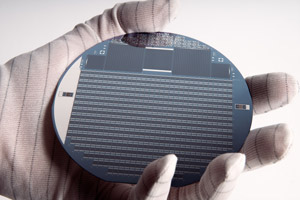Fraunhofer Institute for Solar Energy Systems (ISE) in Freiburg, Germany (the largest solar energy research institute in Europe) has joined forces with EV Group (EVG) of St Florian, Austria, a supplier of wafer bonding and lithography equipment for the MEMS (micro-electro-mechanical system), nanotechnology and semiconductor markets, to develop equipment and process technology to enable electrically conductive and optically transparent direct wafer bonds at room temperature.
Developed in partnership with Fraunhofer ISE based on EVG’s ComBond technology (unveiled in March), the new solutions aim to enable highly mismatched material combinations such as gallium arsenide (GaAs) on silicon, GaAs on indium phosphide (InP), InP on germanium (Ge) and GaAs on gallium antimonide (GaSb). Direct wafer bonding provides the ability to combine a variety of materials with optimal properties for integration into multi-junction solar cells, which can lead to new device architectures with unparalleled performance, it is reckoned.
“Using direct semiconductor bond technology developed in cooperation with EVG, we expect that the best material choices for multi-junction solar cell devices will become available and allow us to increase the conversion efficiency toward 50%,” says Dr Frank Dimroth, head of department ‘III-V – Epitaxy and Solar Cells’ at Fraunhofer ISE. The aim of the partnership is to develop industrial tools and processes for the application.
III-V multi-junction concentrator solar cells on 4-inch diameter wafer.

Fraunhofer ISE has developed III-V multi-junction solar cells for more than 20 years and has reached record energy conversion efficiencies of up to 41% with its metamorphic triple-junction solar cell technology on Ge substrates. Higher efficiencies require the development of four- and five-junction solar cells with new material combinations to span the full absorption range of the sun’s spectrum over 300-2000nm. The integration of III-V solar cells on silicon opens another opportunity to reduce manufacturing cost, especially when combined with modern substrate lift-off technologies. Direct wafer-bonding is expected to play an important role in the development of next-generation III-V solar cell devices with applications in space as well as in terrestrial concentrator photovoltaics (CPV).
“Fraunhofer ISE’s broad expertise in the area of PV, specifically in concentrated PV cell manufacturing and photonics, will allow us to characterize bonding interfaces with respect to PV applications on our new ComBond equipment platform,” says Markus Wimplinger, corporate technology development & IP director at EVG.
EVG’s ComBond technology was developed in response to market needs for more sophisticated integration processes for combining materials with different lattice constants and coefficients of thermal expansion (CTE). The process and equipment technology enables the formation of bond interfaces between heterogeneous materials – such as silicon to compound semiconductors, compound semiconductors to compound semiconductors, Ge to silicon, and Ge to compound semiconductors – at room temperature, while achieving what is claimed to be excellent bonding strength. ComBond technology will be commercially available later this year on the new EVG580 ComBond 200mm modular platform currently in development, which will include process modules designed to perform surface preparation processes on both semiconductor materials and metals.
In addition to PV, other potential application areas for processes developed in cooperation between EVG and Fraunhofer ISE include light-emitting diodes (LEDs) and silicon photonics.





